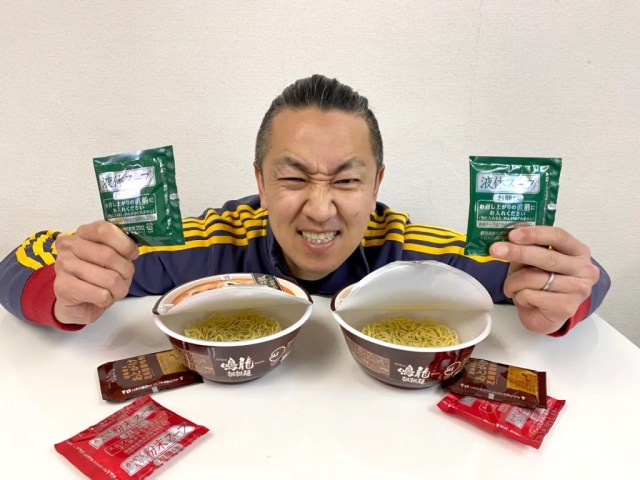
We find out if post-loading your ramen is better than pre-loading.
Our Japanese-language writing team often receives story suggestions from local readers, but one recent message got them thinking more than most. The simple email suggested they look into the world of instant ramen, saying:
“Nowadays, most liquid seasonings are added last, but why don’t you add them first and see if the taste changes?”
This was a challenge that appealed to our instant ramen-loving reporter P.K. Sanjun, who immediately headed out to his nearest convenience store to pick up two bowls of instant ramen.
▼ He purchased the Nakiryu Tantanmen from 7-Eleven.
Instant noodles like these used to include only powdered seasonings, which needed to be added before the hot water, but in recent years, liquid seasonings, added after the hot water, are also commonly included.
The so-called “post-loading” of liquid seasonings is recommended by noodle manufacturers, and it’s a method P.K. has never questioned…until now. Opening the lids, he prepped for the experiment by adding the regular dry seasonings to both, and popping the liquid seasoning into the one on the right.
P.K. has been so conditioned to adding the liquid seasoning after the hot water that just doing this made him feel guilty.
Grabbing the kettle of boiling hot water, he carefully poured the liquid into both and left them to sit for three minutes, as per the instructions.
When the time was up, he pulled the lids off both tubs, added the liquid seasoning into the one that didn’t have it, and lined them up side by side for a visual inspection.
▼ Pre-stirred, they looked markedly different, but after a good mix…
▼…there was no noticeable difference between them.
Now all that was left to do was taste the two of them, and P.K. made sure to get a generous mouthful of each for a fair tasting.
After gulping down two large mouthfuls, he was surprised to find there was no major difference in the taste of the soup, but what he did notice was…
▼ …a massive difference in the noodles.
The noodles in the tub with the pre-loaded seasonings were hard to loosen, with some tough strands remaining in the mix. On the other hand, the noodles in the tub made according to the manufacturer’s recommendations loosened up easily, with an even texture throughout.
This was a result P.K. hadn’t expected, so he picked up the phone and put a call in to the public relations department at Nissin, the Japanese company that first created instant noodles in 1958 and still retains the lion’s share of the market. As professionals in the industry, they were able to tell him why his noodles had been affected, and why the liquid seasonings really should be added after the hot water, saying:
“A common seasoning that’s added later is liquid soup, which has a high oil content. If this is added first, the surface of the noodles will become coated in oil, making it difficult for the hot water to soak through them. Pre-loading with the soup sachet may also cause the temperature of the hot water to drop, which can prevent proper rehydration of the noodles.”
Well, that certainly made a lot of sense to P.K., and now that he knows the reasons behind the manufacturer’s recommended preparation method, he’ll be following it religiously from now on.
The recommended method allows you to get the most delicious results from your instant ramen, so next time you’re tempted to pre-load everything all at once before adding hot water, we urge you to stop and think twice about it.
It might seem like slightly more effort, but the results are well worth it. There are times when it pays to throw the ramen rule book out the window, but when you want to get the best out of your ramen, sometimes it’s best to play by the rules.
Photos ©SoraNews24
● Want to hear about SoraNews24’s latest articles as soon as they’re published? Follow us on Facebook and Twitter!
[ Read in Japanese ]